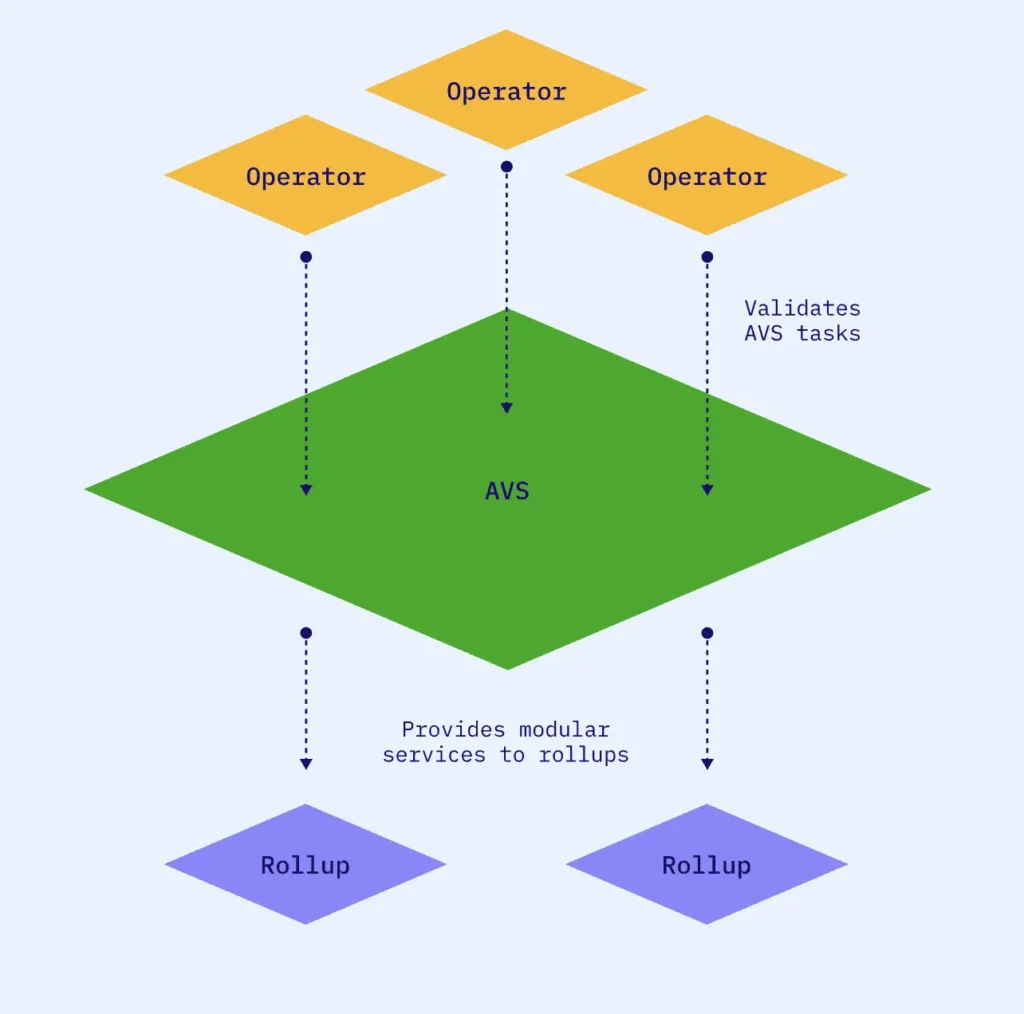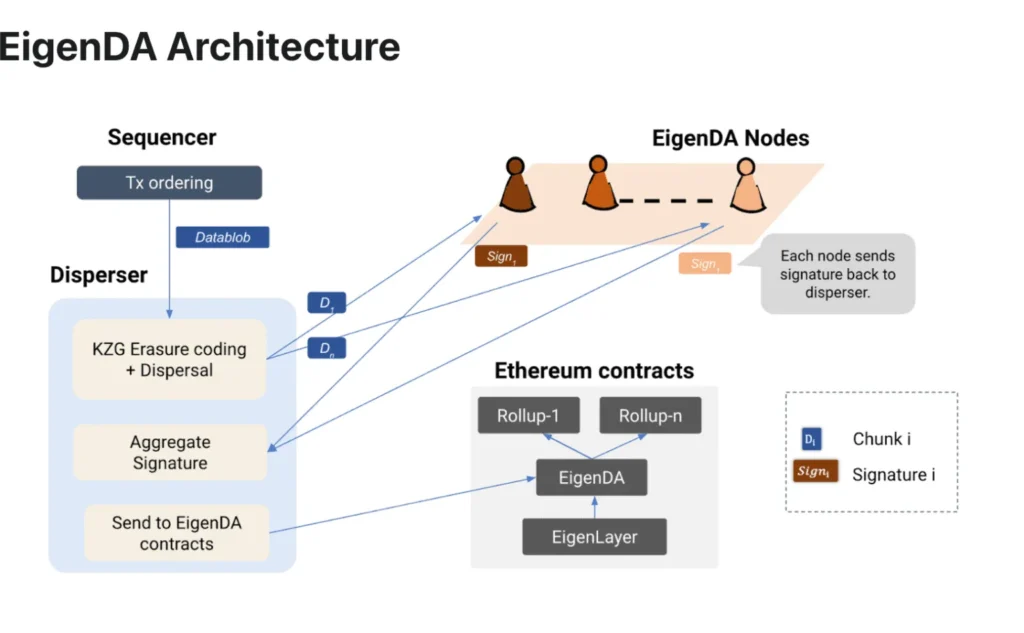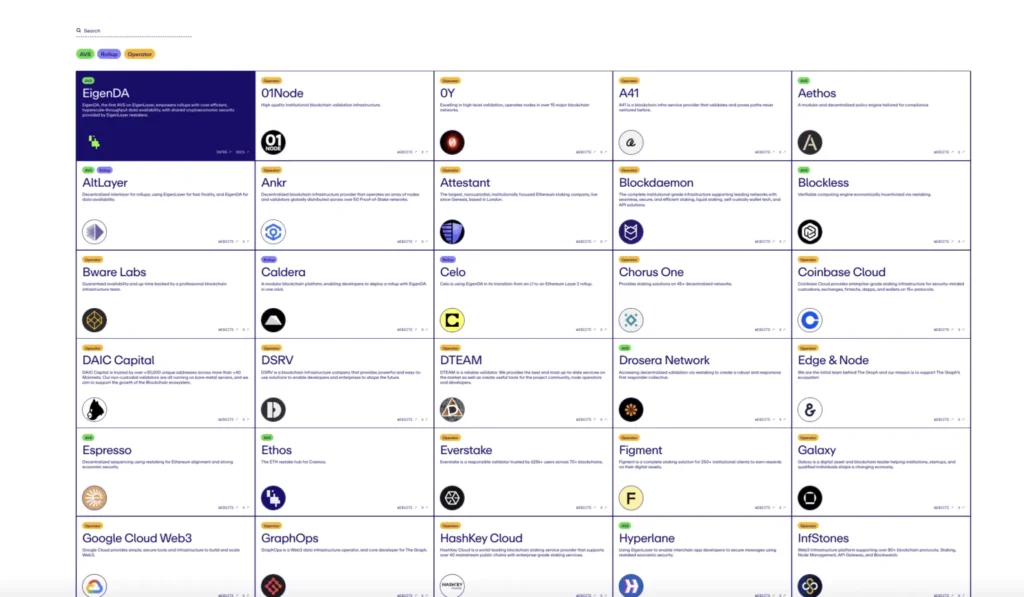In 2022, Ethereum switched to a proof-of-stake system, where Ethereum staking took over from Ethereum mining, creating new opportunities for staking rewards and network security. But Ethereum staking was not the end of the journey. The network has witnessed many new innovations and improvements, with EigenLayer being one of the latest additions to the space.
EigenLayer introduces Ethereum restaking, a novel idea where staked Ethereum can be used to provide security to other components of the network — bridges, protocols, oracle networks, scaling solutions, and more. This enables stakers to earn extra rewards from these entities, helping increase their returns. This guide explores EigenLayer in more detail, examining its workings, advantages, risks, and overall effect on the Ethereum network.
What is restaking?
Before diving into EigenLayer, it is useful to briefly explain Ethereum restaking as a concept. As part of the Ethereum merge and ETH 2.0 upgrade plan, the network adopted the concept of validators for securing the network. These validators stake their ETH as a pledge to the chain, helping protect the entire network.

However, Ethereum is not just a simple chain; it has many AVS or Actively Validated Services built on it. From oracles to bridges to DApps to other decentralized finance (DeFi) protocols, these elements also need security, according to the proof-of-stake (PoS) model. Restaking removes the need for the AVS to have their own validators, allowing network-staked Ethereum to act as the first line of defense against malicious actors.
Ethereum restaking can be seen as pooled or borrowed security without compromising the integrity of the staked ETH in the first place. EigenLayer pioneered this idea, allowing a unified interface for the standard stakeholders to offer security to a wider range of protocols.
Did you know? Restaking as a concept also creates new use cases for the Ethereum network. These include data availability for layer-2 rollup solutions, improved cross-chain transactions, decentralized sequencers ensuring effective transaction ordering, and Miner Extractable Value (MEV) managing solutions.
What is EigenLayer?
To begin with, EigenLayer is a protocol built on top of Ethereum in June 2023. Sreeram Kannan is the creator of the protocol. His vision was to enable ETH stakers to extend the network’s security and trust to other apps and services without a new set of validators. The idea with EigenLayer is to reduce network startup and management costs and eliminate the difficulties that come with bootstrapping security for new projects.
To repeat, EigenLayer is still a fairly new tool that aims to address the following:
Security scalability issues
Problems related to capital efficiency
Stagnating staking rewards
EigenLayer enhances Ethereum’s role as a foundational blockchain and paves the way for a more interconnected ecosystem of services and DApps. Plus, it has benefits for restakers and operators, who are given the task of restaking to AVS, and developers, who build new Ethereum protocols.
Here is another way of thinking about it.
Imagine the staked ETH as solar panels you have installed to capture sunlight and generate electricity for your home — Ethereum. EigenLayer can be seen as a power routing system that can contribute to a community grid or a neighborhood lighting array, as long as your home needs are being met in the first place.
This concept of leveraging or outsourcing solar energy is similar to restaking.
A Guide to EigenLayer
There is a lot of complex terminology on this topic, but EigenLayer and its role are fairly simple and easy to understand. It is a protocol with a significant DeFi presence, thanks to the value locked. The value comes from the staked ETH that people put or are putting into the EigenLayer protocol, enabling it to extend the same to the AVS automatically.

“What if a ZCash network leveraged Ethereum economic security and decentralization via “restaking”? @eigenlayer Can run any consensus protocols as long as slashing is possible.”
Sreeram Kannan, Creator of the EigenLayer: X Elements of Eigenlayer For those who are not familiar, EigenLayer, at its core, consists of the following:
AVS: Protocols or services (DApps) built on top with Ethereum as the main base.
Restaked rollups: Examples include AltLayer, which improves execution scalability with the help of EigenLayer Validators.
Operators: Entities in charge of maintaining network integrity and validating transactions within the EigenLayer ecosystem. At its current state (as of February 2024), EigenLayer doesn’t let validators choose the AVS they want to secure. The process is automatic. By the time actual AVS-based restaking comes into effect, specific protocols, services, and sidechains will get specific attention.
Another interesting thing about EigenLayer is that it doesn’t interfere with the foundational security of the Ethereum network. Instead, it mainly relies on two concepts — pooled security and free market governance.
The first one — pooled security — is at EigenLayer’s core. The idea here is to take the collective security posture of the Ethereum network and extend the same to other protocols and even blockchains. You can think of it as a “neighborhood watch program.”
The concept of free market governance comes from the AVS, which can offer higher rewards for more staked ETH security. As staking rewards exist, the governance model of each protocol, however small, can include the mainnet users.
Understanding the EigenDA
The EigenDA is an actively validated service within the EigenLayer ecosystem. At its core, EigenDA is a data availability service on top of Ethereum, serving the rollup solutions. Like any other AVS, EigenDA uses the restaked ETH to secure itself further without having to depend separately on a validator network.

If you are curious about other actively validated services that EigenLayer restakes to, besides the EigenDA, here are the top few options:
AltLayer: A tool provider for the Rollups-as-a-Service model, which depends on the EigenLayer validators for state transition verification. Blockless: It uses the EigenLayer restakers to achieve trustless computing.
Celo: It stands for decentralized sequencing and liquidity sharing via EigenLayer’s availability layer. Apart from the mentioned name, other options include Omni, Hyperlane, and Espresso, each with a functional utility.
Notably, the EigenDA forms the availability layer of the EigenLayer, which also includes the restaking infrastructure and the base architecture with other protocols built on top of it.
How to use EigenLayer restaking?
EigerLayer restaking, handled via the EigenLayer interface, happens in one of two ways. The first approach involves native restaking where validators holding onto their Beacon Chain staked ETH — 32 ETH — can create EigenPods, change the validator withdrawal address to the EigenPod address, and start restaking.
How to use EigenLayer restaking? EigerLayer restaking, handled via the EigenLayer interface, happens in one of two ways. The first approach involves native restaking where validators holding onto their Beacon Chain staked ETH — 32 ETH — can create EigenPods, change the validator withdrawal address to the EigenPod address, and start restaking.
Staking rewards and the restaking perks from the AVS are credited to the EigenPods. You can directly unstake and withdraw the same after a 7-day escrow period.
But then, if you aren’t an active validator and have only staked ETH via liquid staking providers like Lido and Swell — following the tokenization route — EigenLayer lets you restake the liquid staking tokens too. The next deposit window for EigenLayer opens on Feb. 5, 2024. This time, a few limits have been imposed to prevent concerns related to centralization.
One such limit is the 33% cap on the allocation of LST/LRT tokens and single deposits to promote restaking diversification.
The concept of paused deposits
If you are already on the EigenLayer interface, you might see that some deposits from select custody options and staking providers have been paused. This might be due to one of the many Ethereum EIPs. There is the EIP-7514, which sets a validator churn limit — the rate at which validators enter and leave. Per this limit, there might be slowness in the activation of staked assets, which might impact the restaking pace. This EIP is a built-in measure to safeguard the Ethereum infrastructure.
What’s built on top of EigenLayer?
While we did see what AVS options are built atop EigenLayer, there are liquid restaking platforms that also leverage the infra of EigenLayer.
These include the likes of Renzo, which allows for direct ETH restaking via the Beacon Chain. The EigenLayer, Ether.Fi, leads the liquid staking platform race with its Liquid Restaking Token, eETH, and Kelp — featuring a reward system called Kelp Miles to incentivize users depending on how much and for how long they restake.

How EigenLayer Benefits Ethereum and Beyond
Now that you have some idea about the restaking pioneer — EigenLayer — let us explore some of its benefits:
Increased capital efficiency as instead of locking native ETH, staked ETH can be used to lend security to protocols. An opportunity for higher rewards, with staked and restaked ETH attracting a separate set of perks. Access to novel AVS and DApps in the form of EigenDA’s data availability functionality. Some novel protocols, secured by restaking via the EigenLayer, can also help reduce Ethereum gas fees. EigenLayer’s data availability layer enables higher transaction throughput as many processes need not queue up unnecessarily, making the Ethereum network more efficient. No need to worry about custody options, as the staked ETH is always in your control. Restaking the tokenized versions of self-custody ETH from the likes of ANKR and LIDO doesn’t mean handing them over to EigenLayer. A comprehensive security suite comprising periodic audits, multisig governance, guardrails, and withdrawal escrow. It is worth noting that the quality of smart contracts in play, which play a role in restaking, is top-notch. This means measures have already been put into the code to avoid overcommitment of resources.
What are the concerns?
Eigenlayer does come with its fair share of challenges and concerns. These include:
Slashing risks, which, if inflicted, can cut through the staked ETH rather quickly. However, this only happens if the validators in charge of the staked ETH misbehave.
Yield risks, with stakers chasing the high yield AVS, lowering the yields for the actual users of the protocol.
Centralization risks, which might pose systemic risks to the Ethereum network if the staked ETH is concentrated in a few restaking pockets. This risk is similar to the concerns related to the staking pools.
As mentioned earlier, EigenLayer involves smart contracts. And despite their high quality, this does bring some security risks. Some smart contract security risks include reentrancy attacks, gas limit issues, and parameter attacks.
What does EigenLayer mean for broader blockchain ecosystems? A technical concept at heart, the EigenLayer isn’t all brawn. Instead, it could very well transform the decentralized finance (DeFi) space, first by addressing the issue of fragmented trust and then by making another staking-based asset class available for users. Newer protocols, instead of setting up full-fledged infrastructure for security and just piggybacking, can pave the way for a more unified Ethereum as part of its ETH 2.0 upgrade.

